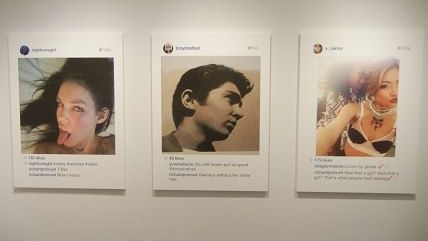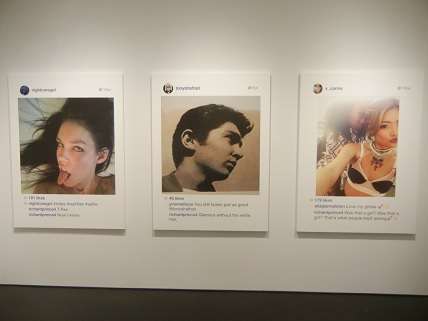Rephotographer Selling Prints of Other People's Instagram Photos for $90,000
Art and law


Pharrell Williams can't write a song with a 70s soul feel and cowbell without getting sued, successfully, by the estate of Marvin Gaye. Williams, of course, denied he had copied elements of Gaye's song "Got to Give It Up" when coming up with "Blurred Lines," but the Gaye estate insisted despite the two songs being played in different keys, with different bass lines, and different lyrics and melodies, "Blurred Lines" had copied the "feel" of Marvin Gaye. It's a dangerous precedent that could have a chilling effect on musical development. Another route is what Sam Smith's attorneys did when Tom Petty's attorneys said one of Smith's songs sounded like one of Petty's songs—give him a co-writing credit, a cut of the money, and move on. Smith said he'd never heard of Tom Petty's "Won't Back Down." But Williams was fighting a good fight—defending not just his right to produce a song like "Blurred Lines" but the rights of all creators to create work without fear that it "feels" too much like something done in the past.
Williams couldn't argue his work was "transformative" because he denied the one song had anything to do with the other. In music it may not always help. Williams is also from the generation of hip-hop producers who came up after the 1991 case that transformed the rap environment by limiting the ability of producers to sample songs without paying royalties. It wasn't transformative enough. Such restrictive copyright laws don't comport with the stated intentions of copyright law—securing a limited time for artists to have the exclusive right to their creation while promoting the progress of the arts.
Not every artistic field has a copyright climate as restrictive as the one being constructed by the music industry. Via the Washington Post:
This month, painter and photographer Richard Prince reminded us that what you post is public, and given the flexibility of copyright laws, can be shared — and sold — for anyone to see. As a part of the Frieze Art Fair in New York, Prince displayed giant screenshots of other people's Instagram photos without warning or permission.
The collection, "New Portraits," is primarily made up of pictures of women, many in sexually charged poses. They are not paintings, but screenshots that have been enlarged to 6-foot-tall inkjet prints. According to Vulture, nearly every piece sold for $90,000 each.
How is this okay?
The Washington Post goes on to explain that Prince has been a "rephotographer," who photographs other photographs and alters them to make them his own, since the 1970s. He faced a lawsuit after photographing a French photographer's photos of Jamaica's Rastafari community, but won on appeal
The Post also has a comment from Instagram:
"People in the Instagram community own their photos, period. On the platform, if someone feels that their copyright has been violated, they can report it to us and we will take appropriate action. Off the platform, content owners can enforce their legal rights."
Prince's artwork upsets a lot of people, like the Post writer, who also points to Prince's embrace of comments critical of him. All too often, when there are different standards in different domains, a lot of people will insist that whichever standard is worse ought to be applied across the board. Williams' "Blurred Lines" case (separated from the unlikable Robin Thicke) seems more sympathetic than Prince's. But demanding photographers and visual artists be held to the same stifling intellectual property environment as recording artists would be unfortunate and wrong-headed. Social media may be the low-hanging fruit of pushing copyright boundaries, but Prince is gathering that fruit and making a dollar, or 90,000, off of it. There's a lesson there about complaining and doing. For an art crit take on Prince's Instagram work, read here.


Show Comments (58)